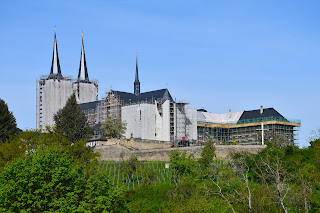Germany Trip – Day 1: Bamberg and Nuremberg
Not long ago, I decided to stay in the UK while looking for a new job, which has allowed me to finally check an item off my bucket list: to make a rail journey from Prague to London. Sketching out a list of places I wanted to see, I decided to cluster my journeys around two centres rather than sleeping in a different city each night. The first of these centres was Nuremberg, which serves as an ideal base for exploring Upper Bavaria. After finding out that rail connections to Nuremberg are quite a pain, I immediately ditched my initial resolution and took a direct bus instead.
The next
morning, I rode the nine o’clock train to Bamberg. Known for its timber houses
and pastel colours, Bamberg is a popular destination for tourists (as well as,
unfortunately, Nazis: Adolf Hitler held a conference there in 1926 as it was
relatively close to the residences of rebellious northern faction leaders). The
town reached the peak of its glory under the rule of Roman Emperor Henry II and
his wife Kunigunde of Luxembourg. Henry II carved it out as a new diocese,
founding its cathedral and the impressive Michaelsberg Abbey, and inviting Pope
Benedict VIII there for a political discussion.
My first
stop in Bamberg, Geyerswörth Castle, was unfortunately undergoing extensive
renovations, but entry to the scenic bridge remained unrestricted. From it, one
can see Bamberg’s iconic town hall tower, which stands in the middle of the
river and is connected to land on both sides with a single-arched bridge.
Legend has it that citizens built the town hall in this strange place after the
bishop refused to grant them a single inch of land for this purpose. Over the
years, the town hall was adorned with beautiful frescoes, and a multi-storey
timber house was glued to its southern side. To this day, wooden beams support
the bottom of this annex where it precariously hangs over the river.
After
wandering about the old town, I continued westwards where I climbed the small
hill to Bamberg Cathedral. The massive 13th century structure stands
opposite the 17th century Residence, and on the western side the Old
Court completes the quadrangle. Perhaps the most remarkable part of Bamberg
Cathedral are its intricately carved stone portals, which display patterns as
well as human figures in niches.
Having seen
all I wanted to see in Bamberg, I took the train back to Nuremberg again. I was
particularly careful with the timing, as from what I could tell, I was only
entitled to a discount on certain trains. The day before I set off on my trip,
I had bought a 25% discount pass on the Deutsche Bahn app, and I decided I
would make it worth every single cent.
Nuremberg
is a lovely city, having rebuilt most of its historical heritage after the old
town was levelled by allied bombing in WWII. Its centre is still contained by
city walls, which are guarded at several points by large towers. The tower
closest to the train station is the Frauentorturm, and it is surrounded by a
collection of quaint wooden houses which serve as restaurants and souvenir
shops. From this tower, the street leads directly to the Saint Lawrence Church,
a luminous place of worship with a giant rose window, and continues to the
Museum Bridge over the river Pegnitz.
During the
Middle Ages, Nuremberg was one of the most important cities in Europe, benefitting
from its position on the lucrative trade route between Italy and Northern
Germany. In 1356, Holy Roman Emperor Charles IV issued a bull that required the
first imperial diet of a newly elected emperor to be held in Nuremberg.
Charles’ son Sigismund further decided that the imperial regalia be held
permanently at Nuremberg, from whence they only departed to escape Napoleon’s
invasion in 1796. The city became a centre of the German Renaissance thanks to
figures like Albrecht Dürer, who was born, lived, and died in the city. Another
famous native of Nuremberg was Johann Pachelbel, born in 1653.
Most
people, however, know Nuremberg for its more recent history. After touring the
old town with its castle and churches (the Frauenkirche was likely designed by
the same architect as the one who built Charles Bridge in Prague), I took the
metro west to the Nuremberg Trials Museum. This is where, after WWII, most of
the Nazi leaders were taken to court and sentenced by judges nominated by the
victorious powers. Some of the most influential figures within the Nazi regime
received the death penalty, such as von Ribbentrop, Frank, and Göring, though
the last escaped execution by committing suicide.
Taking the
metro and S-Bahn to the very opposite end of the city, I then made a loop
around the Nazi party rally grounds. These include the massive semi-circular
Congress Hall and the Zeppelinfeld. When American forces reached the city in
April 1945, they bombastically blasted the swastika off the main tribune.
















































Comments
Post a Comment